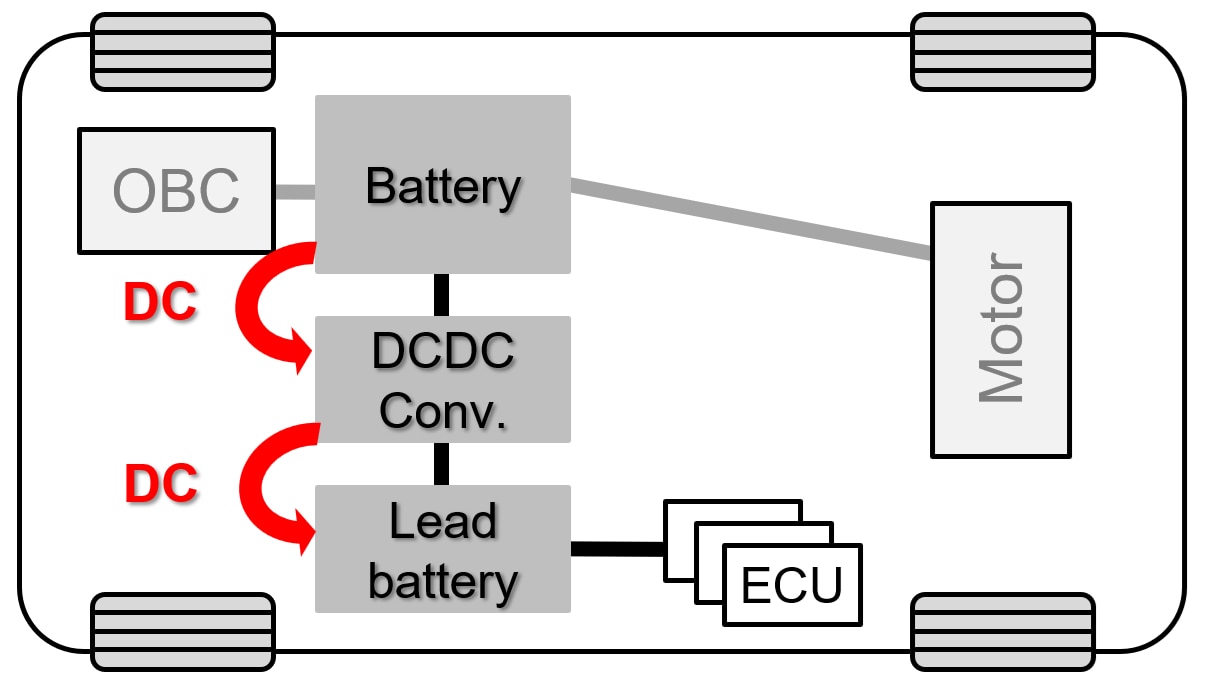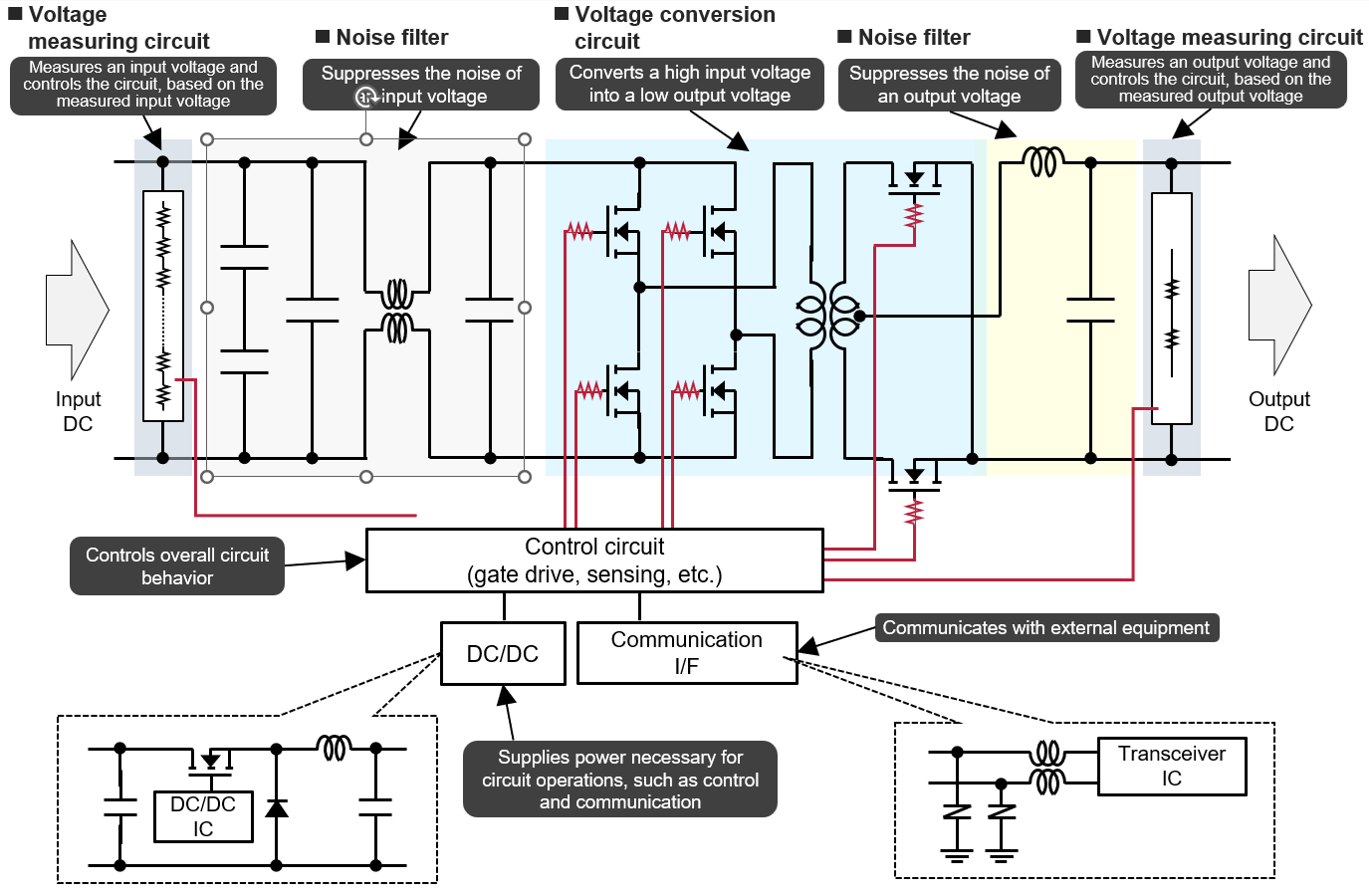Essential Power Conversion for Safe and Efficient EV Operation
Electric vehicles (EVs) rely on two types of onboard batteries: a high-voltage lithium-ion battery and a low-voltage lead-acid battery. While the lithium-ion battery powers the drive motor and is charged via external charging stations, the lead-acid battery supports auxiliary systems and must be charged internally—from the lithium-ion battery. This is where the DC/DC converter plays a critical role: it transforms high-voltage DC power into low-voltage DC power, enabling safe and efficient operation of various vehicle systems.
Why DC/DC Converters Are Essential in EVs
Modern EVs are packed with electronic components—from ECUs and cameras to lighting systems—all of which operate on low-voltage power. However, the main drive motor requires high-voltage power (typically 400V or more) to reduce current flow and improve energy efficiency. Without a DC/DC converter, these systems would be incompatible with the vehicle’s power architecture.

High vs. Low Voltage Applications
- High Voltage (400V+): Used for drive motors and other high-power systems. High voltage reduces current, minimizing energy loss and improving efficiency.
- Low Voltage (12V): Powers auxiliary systems such as infotainment, lighting, and control circuits—even within high-voltage devices.
Why 12V Is the Standard
The 12V standard originates from early automotive systems that used lead-acid batteries to power starter motors. Today, passenger vehicles still use 12V systems (6 cells × 2.1V), while larger vehicles like trucks often use 24V systems for higher torque requirements.
Market Trends and Future Outlook
As EV adoption accelerates globally, the demand for DC/DC converters is expected to rise significantly. Additionally, the electrification of more vehicle systems is driving the need for:
- Higher output power
- Smaller form factors
- Greater thermal resistance
- Higher precision and reliability
Panasonic Industry is at the forefront of this evolution, offering a comprehensive lineup of automotive-grade components designed to meet these demanding requirements.
DC/DC Converter Circuit Architecture
A typical DC/DC converter consists of several key functional blocks:
- Voltage Detection (Input/Output): Measures voltage levels to control conversion accuracy.
- Noise Filters: Suppress electromagnetic interference using inductors and hybrid aluminum electrolytic capacitors.
- Voltage Conversion Circuit: Uses switching elements and transformers to step down voltage.
- Control Circuit: Manages switching operations and overall system behavior.
- Communication Interface: Enables external communication via CAN or Ethernet, protected by chip varistors against ESD.

Key Components Used
- Film Capacitors: For input/output noise filtering
- Hybrid Aluminum Electrolytic Capacitors: For smoothing and noise suppression
- Automotive Power Inductors: For voltage conversion
- High-Precision Chip Resistors: For voltage measurement
- Chip Varistors: For ESD protection in communication circuits
Panasonic’s Component Solutions for DC/DC Converters
Panasonic Industry offers a wide range of high-performance components tailored for automotive DC/DC converter applications:
- Automotive Film Capacitors
- Hybrid Aluminum Electrolytic Capacitors
- Automotive Power Inductors
- High-Precision Chip Resistors
- High-Power Chip Resistors
- Chip Varistors
Conclusion
DC/DC converters are indispensable in EVs, enabling the safe and efficient operation of low-voltage systems from high-voltage sources. As EV technology continues to evolve, the demand for compact, high-output, and thermally robust converters will grow. Panasonic Industry is committed to supporting this transformation with advanced electronic components that meet the highest standards of automotive reliability.
| Component | Feature | High voltage | Large current | Low loss | Miniaturization | High heat resistance | High precision |
| Film Capacitors (Automotive, Industrial and Infrastructure Use) | High reliability |  |
 |
||||
| Conductive Polymer Hybrid Aluminum Electrolytic Capacitors | Low ESR High reliability |
 |
 |
 |
 |
 |
|
| Power Inductors for Automotive application | Large current, low loss High reliability |
 |
 |
 |
 |
||
| High Precision Chip Resistors Small & High Power Chip Resistors |
High precision, high resistance to heat |  |
 |
 |
 |
 |
|
| Chip Varistor | Small and light |  |

